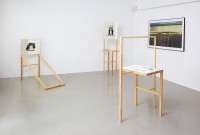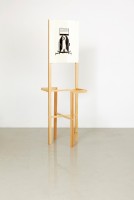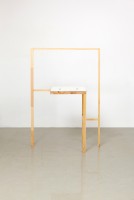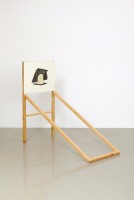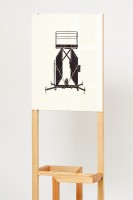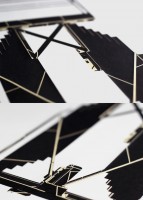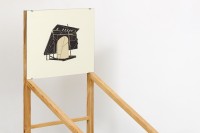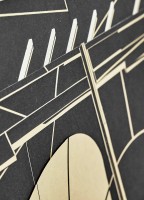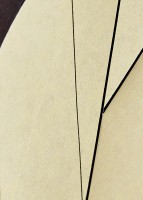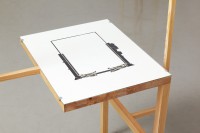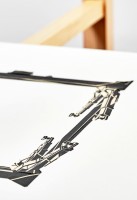Inverse | Kisterem Gallery | 2015
Curator: Mónika Zsikla
3 December 2015 – 15 January 2016
INVERSE is an exhibition of works by three artists, debuting at the Kisterem Gallery. As members of the youngest generation, all three artists have adopted a post-digital attitude in creating their reduced pictorial surfaces. Each of the works on display is inversely related to the object it replicates, to the aesthetic vernacular of its associated precursor, and to perspective.
Márk Fridvalszki’s series, collectively titled “Hagere Geometrie”, consists of conceptual collages inspired by 21st-century high-tech military industrial aesthetics and innovation. The most emphatic elements used in the series, which draws from corporate industrial and alienated technocratic design, are arched forms, barbed, metallic shininess, (aero-)dynamic lines, and grey tones that are kept in an apparently neutral state of transition between black and white. Adding a sense of contrast to accompany the lifeless, devitalised hues of grey, there is the occasional geometric green surface, alluding to living and thriving nature. However, making its presence strongly felt as part of the series is an F-15 fighter-bomber aircraft, one of the hi-tech military machines used during NATO’s interventions in the Middle East. In the alcove, papered with a scene of a barren landscape, the silver-framed collages suspended on the wall like an installation of solar panels, together with the statuesque model of the fighter jet, conjure up the impression of the interior of a tycoon’s office, with a view over an apocalyptic desert. The visual language of Fridvalszki’s illusion, which wavers between utopia and reality, recalls the geometry of the boundless futurology of early twentieth-century Constructivism and Suprematism. The same is true for András Zalavári’s laboratory of cube experiments.
Zalavári’s black-and-white par excellence works of cubes floating in horizonless spaces, reminiscent of Moholy-Nagy’s photography from the early twentieth century, explore the experimental possibilities of making images. The situative circumstances that are intended to provide insight, however, do not in any way enlighten us about the actual order in which the images were created, for even after lengthy contemplative analysis there remains uncertainty as to whether the photographs are pictorial renderings of the experimental cube arrangements drawn onto the desk or folded out of photosensitive paper, or vice versa. The viewer, oscillating between 2-D and 3-D surfaces, is brought no closer to the pictorial truth (or the truth of the picture) by the colour blow-up on the opposite wall. Next to the windows on one side of the space – those opening onto the ‘unheimlich’ fog of the portentous desert – the large image on the opposite wall is a panorama of Heroes’ Square in Budapest. In this colour photograph, composed from several thousand sequences, Zalavári uses two sets of perspective construction principles to deceive the viewer’s eye. The combination of simple (linear) perspective in the vertical and inverse (Byzantine) perspective in the horizontal results in a pictorial surface that captivates yet simultaneously marginalises the viewer.
In a change of scene from disorienting spatial perspectives, viewers can rest their eyes on Zsolt Molnár’s hyper-clear collage architectures. His spatially balanced objects operate through two- and three-dimensional representations of the architectures of real, functional tools. The silhouettes of the tools that appear in the collages, which are completely different with regard to their function and application (levelling device, telemeter, working platform), are empty spaces cut out of paper, and they come to life through the basic black-and-white geometric shapes that are placed one above the other on the reverse sides of the paper surfaces. The collages, created from millimetre-accurate paper cut-outs aligned atop one another, sometimes in five or more layers, are arranged as spatial installations, which offer modular pendants to the static structurality of the tools depicted.
Mónika Zsikla
